Main Spotlight: How Communities Are Reimagining Streets for Everyone
Learn how Main Streets in Philadelphia are using active transportation to foster healthier and more connected communities.
Únase a nosotros durante tres días de aprendizaje, conexión y celebración en Main Street Now 2025 en Filadelfia, Pensilvania, del 7al9 de abril.
Asegure su plaza
Marion, Iowa © Tasha Sams
We work in collaboration with thousands of local partners and grassroots leaders across the nation who share our commitment to advancing shared prosperity, creating resilient economies, and improving quality of life.

Emporia, Kansas © Emporia Main Street
Made up of small towns, mid-sized communities, and urban commercial districts, the thousands of organizations, individuals, volunteers, and local leaders that make up Main Street America™ represent the broad diversity that makes this country so unique.

Chicago, Illinois © Main Street America
Looking for strategies and tools to support you in your work? Delve into the Main Street Resource Center and explore a wide range of resources including our extensive Knowledge Hub, professional development opportunities, field service offerings, advocacy support, and more!

Waterloo, Iowa © Main Street Waterloo
Your one-stop-shop for all the latest stories, news, events, and opportunities – including grants and funding programs – across Main Street.

Kendall Whittier — Tulsa, Oklahoma © Kendall Whittier Main Street
Join us in our work to advance shared prosperity, create strong economies, and improve quality of life in downtowns and neighborhood commercial districts.
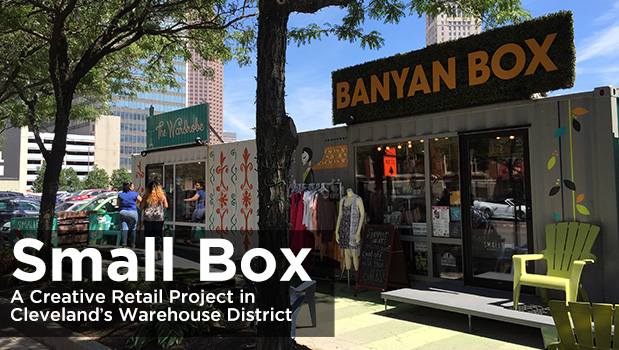
Main Street communities across the country are no stranger to seeking creative strategies to solve their most nagging issues – vacant buildings, marketing downtown, bolstering retail to name a few. Innovation, entrepreneurship or just trying out an idea to see if it works is a part of the daily routine of Main Street organizations. In Cleveland, Ohio, like many rust belt cities, innovation is a part of its legacy. In fact, in 1900, Cleveland produced more patents per capita than any city in America. It was a place where people tried out ideas, failed, and tried again.
This ethic continues to thrive in Cleveland’s revitalization efforts. The Warehouse District – a Main Street community within the downtown central business district – holds a significant part of Cleveland’s historic preservation legacy. It was here that the groundwork for downtown’s revitalization was laid through creative thinking in adaptive re-use and historic preservation development financing. With this legacy, the seed of the idea to create vibrant downtown mixed-use residential community was planted.
Today, downtown Cleveland is experiencing over $1 billion of incremental redevelopment with preservation as the catalyst. Downtown residential population is growing toward 15,000 and office occupancy has enjoyed a stable trend of growth. Now, the community talks less about restoring buildings and more about the personality of place; where to provide public space amenities; and how to provide shopping amenities for the everyday needs of the downtown community.
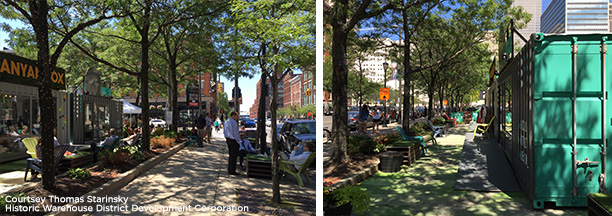
The Small Box enhances the Warehouse District public realm by masking a large surface parking lot. The project addresses the sidewalk in a way that creates a social marketplace on a busy corner. Java & Jive is a weekly lunchtime live music event at The Lawn, the pocket park on two parking spaces adjacent to Small Box. On event days, Warehouse District restaurants offer boxed lunch specials.
In the Warehouse District, the Historic Warehouse District Development Corporation (HWDDC) has focused on residential and commercial development, placemaking, and creating a sense of place through streetscape projects, public art and plans for the public realm. While the District has always thrived as a place to do business, it has struggled to evolve and provide for the needs of the community through the mix of businesses. As massive warehouse buildings were adaptively re-used, it also became a challenge to find businesses that could support the rent for these larger ground floor spaces. When the business mix evolved to restaurants and night clubs with very little soft goods retail, it was apparent that the District needed to develop a thoughtful approach to creating a better mix of uses. By this time – about 2010 – the residential base of the Warehouse District had grown to 3,000, an independent grocery – Constantino’s Market – had opened and there was a need to provide additional shopping amenities.
In addition to the challenge of large spaces, soft goods retailers did not have confidence in market demand. In 2011, HWDDC convened a retail working group that engaged in a retail niche analysis to take a proactive approach in the next evolution of Warehouse District. The analysis succeeded in developing an understanding of the demand for retail in the District. It developed a realistic goal for a mix of businesses in the District that enhanced the existing restaurants, retail and nightclubs. Additionally, it created an understanding of type and size of spaces that retail needed in order to succeed.
It was while I was doing some research for the retail niche analysis that I noticed other cities trying to jump start retail using shipping containers. Dekalb Market in Brooklyn took over a parking lot with containers filled with restaurants and shopping. Shoe manufacturer, Puma, developed a pop up shop using a container. Since that initial research many other cities and entrepreneurs have created shopping developments including BOXPARK http://www.boxpark.co.uk/ in the Shoreditch neighborhood of London, South Street Seaport in New York City and Granary Row in Salt Lake City.
The concept seemed to be a perfect way to solve several issues in the Warehouse District. The 160 square foot space could provide an opportunity with lower rent so that local small businesses could sustain their business and still have time to grow their client base. Additionally, there could be an instant critical mass of retail by placing several businesses next to each other. Their success would help to prove market demand and break through the confidence barrier of other retailers. Further, the containers could be arranged in a manner that would enhance the public realm by being placed in a surface parking lot along the sidewalk, masking the large void in the neighborhood where historic buildings once stood. While there was organizational support for the idea, with a streetscape project about to begin and other funding priorities, the idea needed to wait for the right opportunity.
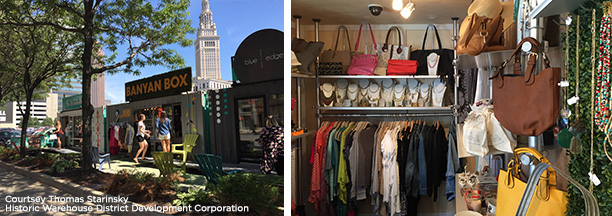
(Left) Cleveland’s iconic landmark, Terminal Tower, provides a great backdrop for the Small Box businesses.
(Right) An interior view of Banyan Box. The Small Box businesses have found that their busiest time of day is during lunch as office workers in the District come out to shop during their break.
This opportunity came in 2013, with Enterprise Community Partners Nurture an Idea initiative – a creative grant program where several organizations with innovative ideas compete in a crowd funding challenge. HWDDC decided to give this opportunity a try. So, we partnered with Cleveland Container Structures, a start-up company specializing in repurposing used shipping containers and submitted a proposal and this seed of an idea became the Small Box retail initiative. Ultimately, we raised $40,000. The crowdfunding campaign alone raised $20,000 with 181 people donating from $10 to $1,000.
With this success, we had a creative idea that captured people’s imagination, and now we needed to take the necessary steps to organize this project from a legal standpoint – partnership agreements, design and construction contracts, a baseline lease agreement and the most important task, the actual location. Thanks to Weston, Inc., the owner of largest parking lot in the District, the location for Small Box became a prime corner in the Warehouse District.
With the donated parking spaces and a construction budget estimate, we finalized design work and permitting. The City of Cleveland recognized the creative nature of the project and was very helpful in the permitting process with the only required variance being to provide bathrooms for employees. Bar Louie, the restaurant across the street, agreed to let employees use their facilities, so we could accommodate the city’s requirement.
The next task was to recruit retailers. The Warehouse District has a strong restaurant presence and the goal of Small Box is to diversify the District’s business mix, so HWDDC only spoke with soft goods retailers. There were also targeted efforts to recruit strong business owners to duplicate their existing businesses or develop a complimentary concept. While everyone we spoke with was enthusiastic about the concept, no one was willing to commit to a lease. The hurdles seemed to be the same as any retailer – the cost of initial inventory, fixtures, signage, and staff.
In July, 2014 the prospect of implementing the project within the projected goal was waning. The question became: should we work to implement the project in time for the holiday season or wait until the following spring?
Then the conversations with retailers began to change. The Cleveland Browns were interested in opening a small team shop for the 2014 season since the Warehouse District saw a lot of fans on game days because the stadium was nearby. At about the same time Christie Murdock, a well established small business owner who has owned a boutique called Banyan Tree for 13 years in Tremont (an adjacent neighborhood) decided that it was time for her to become a part of the surge of downtown retail. Then along came Caroline Dengel, who had earlier that year began roaming from flea markets to special events as the Wandering Wardrobe – a repurposed Fed Ex truck turned women’s clothing store. She felt that Small Box was an exciting concept in a prime location and was interested in a space for a stationary store.
Because the initial phase of the project was to include only two containers, the question moved to how we could find money for a third container in time for the holidays? Through HWDDC’s strong partnership with Downtown Cleveland Alliance, the downtown-wide organization that manages the special improvement district, the project was able to secure additional funding for a third container.
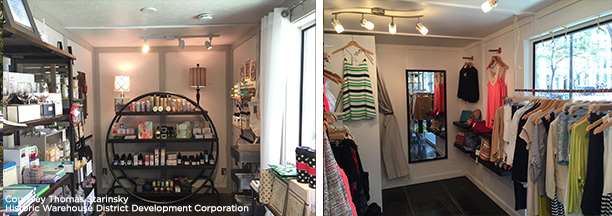
(Left) Blue Edge is a collaboration between two businesses from a suburb of Cleveland - Blue Envelope and Edge Hair Salon. They sell an array of beauty products and gifts.
(Right) The Wardrobe sells fashion forward woman’s clothes. This is the stationary location for Caroline Dengel’s The Wandering Wardrobe, which sells clothes from a repurposed FedEx truck.
With this last push and more parking spaces from Weston, Inc., Small Box signed leases with the Cleveland Browns; Banyan Box, and The Wardrobe, a sedentary version of The Wandering Wardrobe. We were excited to have the first leases achieve a dynamic mix of businesses – a business with national stature; a well established small business and a young entrepreneur.
The three Small Box tenants opened in the fall of 2014 just in time for football season and the holidays along with a pocket park called The Lawn in two adjacent parking spaces. There was great community and media response. Much of the success of each business is due to social media – reminding followers about business hours and teasers about new products and sales.
HWDDC has also stepped up to activate the space around Small Box in a way that engages neighboring businesses and brings more people to the Warehouse District. On the three Thursday evenings in December, Downtown Market at Twilight brought 10 additional venders in tents to the sidewalk in front of Small Box. Music, free blankets and hot chocolate added to the festive atmosphere. Many of the vendors were businesses interested in leasing future spaces at Small Box or perhaps in brick and mortar space. Java and Jive – a weekly lunchtime live music event at The Lawn began this spring to further activate the public space and bring office workers outside. District restaurants responded by providing boxed lunch specials on event days.
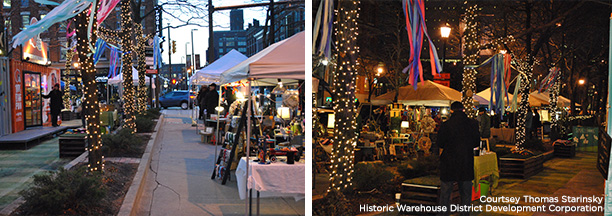
HWDDC held Downtown Market at Twilight at Small Box on the three Thursday evenings in December. The market brought holiday cheer to the District along with ten additional retailers.
Small Box continues to thrive. Both Banyan Box and The Wardrobe renewed their lease after their initial six-month lease. After the Browns’ season, Blue Edge, a collaboration between Edge Hair Studio and Blue Envelope, soon took over their space. The interest in Small Box continues to flourish with a growing list of interested businesses.
As a result, retail efforts of HWDDC and their partners is two-fold. We are working to secure funding for additional Small Box units. Further, we are using the long list of interested businesses to demonstrate the demand for small brick and mortar spaces. With this, we are reaching out to property owners to help them understand how some existing larger spaces can be divided to provide more opportunities conducive to retailers.
Ultimately, it has been the innovative spirit of Cleveland that is fueling Cleveland’s current momentum. Small Box worked. The next idea might not. But, if we want Main Streets like the Warehouse District to continue to thrive and evolve, we must have the ambition to try the next idea with full creative spirit and see what happens.
Thomas Starinsky is the Associate Director for Historic Warehouse District Development Corporation and Historic Gateway Neighborhood Corporation, two Main Street Programs in Downtown Cleveland, Ohio. He brings 17 years of experience in economic development and urban design to his work in Cleveland where he thrives on the challenge of giving downtown personality through creative placemaking.